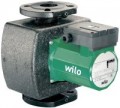Max. flow
The maximum flow of a pump is the amount of liquid it can pump in a certain amount of time.
Features of choosing the optimal performance option depend primarily on the purpose of the pump (see above). For example, for DHW recirculation models, the pump performance should not exceed the performance of the water heater. If the water heater is capable of delivering 10 litres per minute to the DHW circuit, then the maximum pump performance will be 10*60=600 L/h. The basic formula for calculating the performance of a heating system takes into account the power of the heater and the temperature difference at the inlet and outlet, and for the cold water system — the number of points of water intake. More detailed information about the calculations for each application can be found in special sources, and it is better to entrust the calculations themselves to professionals.
Max. head
The head can be described as the maximum height to which a pump can lift liquid through a vertical pipe without bending or branching. This parameter is directly related to the pressure that the pump produces: 10 m of head approximately corresponds to a pressure of 1 bar (do not confuse this parameter with operating pressure — see more about it below).
The head is one of the key specs for most circulation pumps. Traditionally, it is calculated based on the difference in height between the location of the pump and the highest point of the system; however, this principle is relevant only for units that
boost the pressure of cold water(see "Suitable for"). Circulation pumps for heating and DHW work with closed circuits, and the optimal pressure depends on the total hydraulic resistance of the system. Detailed calculation formulas for the first and second cases can be found in special sources.
Minimum fluid temperature
The lowest fluid temperature at which the pump is capable of operating normally.
Almost all pumps can normally transfer cool water, regardless of the purpose (see above); therefore, for normal household use, this parameter is not critical and for some models, it may not be indicated at all. But if you need the ability to work with liquids with temperatures below 15 °C, you should pay close attention to the minimum temperature. Some models that can be used with antifreeze normally tolerate even temperatures below zero.
Max. fluid temperature
The highest liquid temperature that the pump is capable of operating normally.
The possibility of using the unit directly depends on this parameter (see "Suitable for"): for example, models for heating systems must tolerate a temperature of at least 95 °C, and for DHW supply — at least 65 °C. Well, anyway, this parameter should not be exceeded: an overheated pump will fail very quickly, and the consequences of this can be very unpleasant.
Max. power consumption
The electrical power consumed by the pump during normal operation and maximum performance.
This indicator directly depends on performance — after all, for pumping large volumes of water, an appropriate amount of energy is needed. And the power depends on two main parameters — electricity consumption and the load on the power grid, which determines the connection rules. For example, pumps with a power of more than 5 kW cannot be connected to ordinary household sockets; more detailed rules can be found in special sources.
Mains voltage
Operating voltage for which the pump is designed.
— 230 V. Standard voltage of household networks. Most of these pumps can be powered from a regular outlet, which makes them very convenient to connect. At the same time, this option is not well suited for creating high-performance units — already with a power consumption of more than 5 kW, certain tricks in connection will be required, and in general, 230 V provide less power than 400 V. Therefore, the such power supply is typical mainly for models elementary and intermediate levels.
— 400 V. This option implies power supply from three-phase networks with a voltage of 400 V. Such networks are rarely found in everyday life, but they are widely used in the professional field, including at industrial facilities — they are convenient for powering high-power equipment. Therefore, three-phase power is usually provided in professional high-performance pumps.
Shaft material
It is the material from which the motor shaft in the pump is made.
— Cermet. It is a material that combines metals and their alloys with non-metallic components. In modern pumps, different types of cermets can be used, differing in price and quality; usually, the features in each case directly depend on the price category of the unit. However, it is well suited for household models with relatively low performance but is poorly suitable for professional use. Therefore, in pumps of more than 15,000 litres per hour, cermet shafts are rarely used.
— Stainless steel. This material is highly durable and reliable, due to which it is found in almost all categories of pumps — from relatively simple to professional, the performance of which is in the tens of thousands of litres per hour. However, it is somewhat more expensive than cermets.
Inlet
The size of the inlet provided in the design of the pump. For plumbing threads (see Connection), the size is traditionally indicated in inches and fractions of an inch (for example, 1" or 3/4"), for flanges, the nominal diameter (DN) of the bore in millimetres is used — for example, DN65.
This parameter must match the dimensions of the mount on the pipe to which the pump is planned to be connected — otherwise, you will have to use adapters, which is not very convenient, and sometimes not recommended at all.
Outlet
The size of the outlet provided in the design of the pump. The value of this parameter is completely similar to the size of the inlet (see above).

